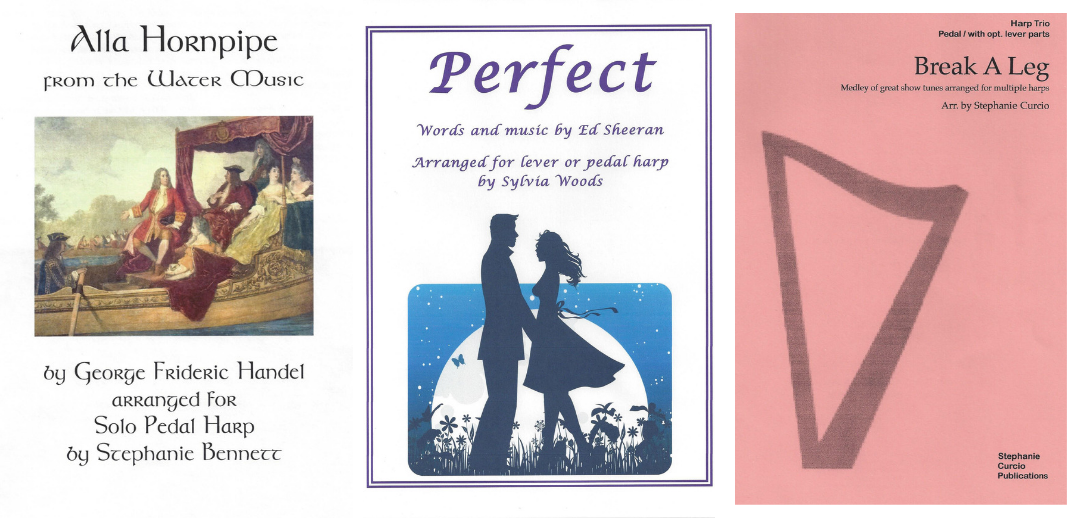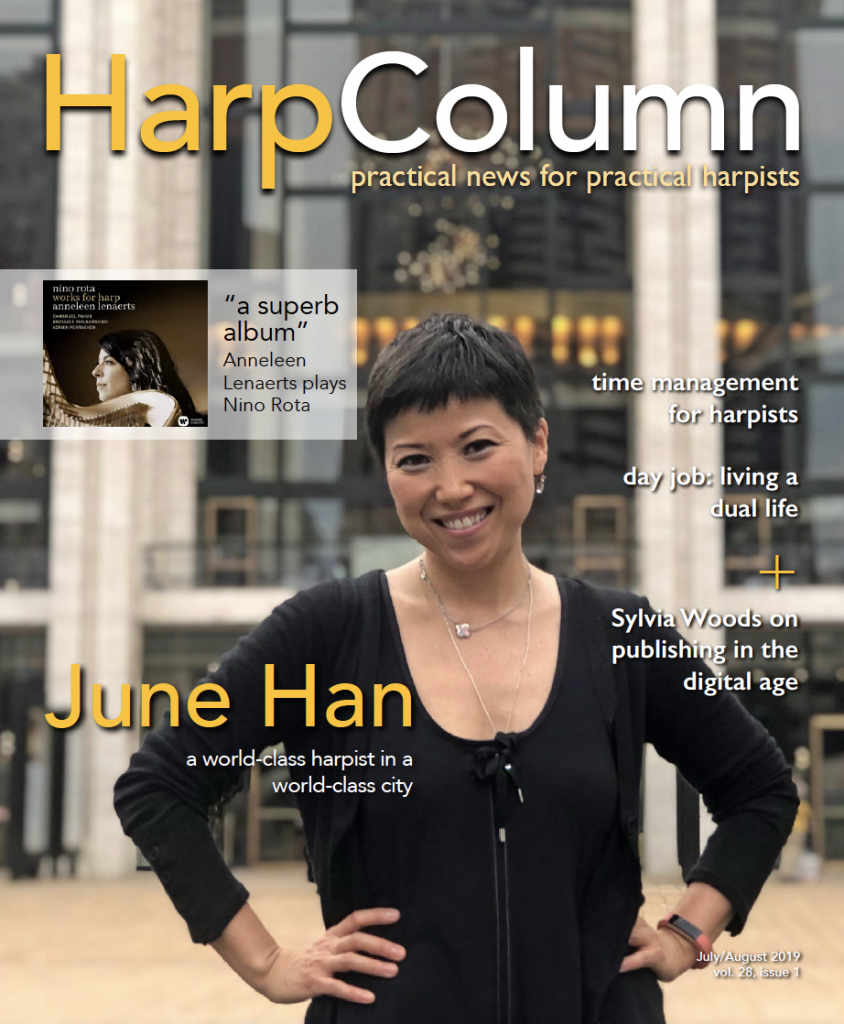
We have a veritable potpourri of offerings this issue—something for everyone! Let’s start with a classic.
Stephanie Bennett has published an arrangement of George Frideric Handel’s “Alla Hornpipe” from Water Music Suite through her Harpworld Music Co. This four-page arrangement for pedal harp makes a celebratory wedding recessional and is also suitable for any joyous occasion.
Bennett’s publication is sight-readable for the intermediate or higher player and is in D-Major. Pedal changes are marked either below the staff or in the middle and she also includes frequent pedal charts. Most of the pedal changes are on the last two pages, and they are all manageable. The page turns are well-planned and the typesetting is easy to read.
She painstakingly notates the fingering and explains her notations in the performance notes, and this arrangement falls comfortably in the hands. You may prefer to play fewer melody notes in the left hand than indicated by Ms. Bennett, such as m. 19. Here it seems more cumbersome to use the left hand, but she encourages the player to use what is comfortable for them.
You may also want to add more octaves to the left hand accompaniment as this is such a grand piece of music. However, it is appealing as is and very useful to have a harp arrangement rather than the doctored-up organ or piano music most of us probably use!
Lever or pedal harp players will find Sylvia Woods’ arrangement of “Perfect” very handy. This popular tune by Ed Sheeran is presented twice: the first is the complete, six-page version and the second is a one verse (two page) arrangement. This second version is exactly the same as the first 52 measures of the complete version with a short ending added. Woods recommends this latter option when playing it for a wedding processional, when you don’t want to worry about turning pages.
There are no accidentals in either version, and it is in G-Major. This is easily sight-readable for an intermediate player. Chord symbols are included so you can embellish at will. Some fingering is suggested. The music is available as a download. You’ll get asked to play this one, so have it ready!
If you play in harp ensemble you’ll like an exciting, new arrangement by Stephanie Curcio. Break A Leg is a medley of show tunes that was commissioned by the Central Florida Chapter of the American Harp Society and published by Stephanie Curcio Publications. It is written for three pedal harps with two optional lever harp parts. This makes it suitable for multiple levels as well as for ensembles that combine pedal and lever harps. Curcio offers individual parts that can be purchased separately and you can also buy a complete set with a score. The optional lever harp parts are not printed on the score. The option to purchase individual parts helps manage the cost of music for all ensemble participants.
The first tune in the medley is “There’s No Business Like Show Business.” Made famous by the iconic Ethel Merman in the stage show Annie Get Your Gun, this rousing number moves along at a pretty good clip. Most of the pedal changes were given to part two in this piece.
All three parts have a lot of pedal changes in the very chromatic “One” from A Chorus Line. At least the tempo slows to a more moderate shuffle, but there are even some double pedal slides in this tune. All of them are well-marked and in the middle of the staff where you won’t miss them. This wonderful melody calls to mind Michael Bennett’s show-stopping choreography at the finale of one of Broadway’s longest running hits.
There are still a fair number of pedal changes in the next selection, the theme from Cabaret. As in the previous two songs, part one handles the melody played in both hands in unison. There is one pedal notation error in part three: an F-sharp is needed the second time around in m. 4, but it is already there in m. 5 both times.
Part one takes a little break at the beginning of the next piece, “And All That Jazz” from Chicago, but not for long. Part one has some fancy footwork with lots of pedal slides that suit the slinky choreography by Bob Fosse. Part three also has some pedaling.
The final piece, “That’s Entertainment,” is the only selection that isn’t from a Broadway musical. This is from the 1953 movie, The Band Wagon, and it’s a great choice to end a medley with a title like “Break A Leg.” Part three has a few big glisses at the end.
Each piece in each part is only one page in length, so the page turns are very convenient. The transitions from one piece to the next are smooth, and Ms. Curcio also includes some familiar “hooks” (such as the intro to “One.”) The trickiest parts of this medley are some of the rhythm and the fast pedaling, but it is suitable for intermediate players.
If you want something that is fun to play and sure to be a crowd pleaser, try Break A Leg! •







